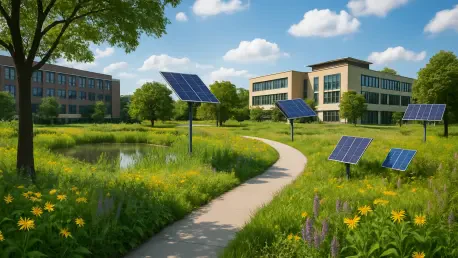Imagine a sprawling university campus where lush lawns and towering trees not only captivate the eye but also nurture the environment in profound ways, creating a harmonious balance between beauty and sustainability. At Penn State’s University Park campus, this vision is becoming reality through a groundbreaking effort to transform the landscape into a model of sustainability and biodiversity. Launched after years of meticulous planning, this initiative seeks to harmonize ecological health with the cherished aesthetic of the campus, preserving iconic features while introducing innovative, low-maintenance designs. With significant donor support and active student involvement, the university is setting a powerful example of how environmental stewardship can intersect with community spirit. This ambitious project promises not only to enhance the campus’s natural beauty but also to serve as an inspiration for other institutions aiming to balance tradition with forward-thinking ecological practices.
Pioneering a Greener Campus Vision
Crafting a Sustainable Blueprint
The foundation of this transformative journey lies in the carefully developed Sustainable Landscape Implementation Plan, a comprehensive strategy born from extensive stakeholder engagement and detailed research. Planners conducted thorough on-site studies and interviews with various campus groups to ensure the initiative reflects both ecological priorities and cultural values. A key focus is transitioning from conventional lawns and isolated trees to more dynamic, environmentally supportive designs like shade meadows that foster biodiversity. These changes aim to reduce maintenance demands while preserving the campus’s iconic charm, such as its heritage trees and open green spaces. By integrating native plant species and innovative landscaping techniques, the plan addresses pressing environmental challenges without sacrificing the visual and historical essence that defines the University Park campus. This strategic approach ensures that every step forward aligns with long-term sustainability goals, setting a benchmark for other educational institutions to follow.
Selecting the First Transformation Site
Attention quickly turned to identifying an ideal location for the inaugural project, with Chapel Woods emerging as the perfect candidate due to its unique characteristics. Situated near key campus landmarks, this area offers a dense tree canopy that creates optimal conditions for establishing a 20,000-square-foot shade meadow. This pilot project exemplifies the broader goals of enhancing ecological diversity while minimizing upkeep, as the meadow will replace traditional turf with native plants better suited to the local ecosystem. The selection process considered not only environmental factors but also the site’s visibility and accessibility, ensuring it serves as a tangible demonstration of sustainable landscaping for the campus community. This initial transformation is designed to inspire similar efforts across other campus areas, proving that small, targeted interventions can yield significant environmental benefits. The Chapel Woods project stands as a testament to the power of strategic site selection in driving meaningful change.
Community and Financial Backing Fuel Progress
Generous Alumni Support Drives Momentum
A pivotal element propelling this initiative forward is the substantial financial contribution from alumni Harry Burns and Pat Wirth, whose generosity has provided both immediate and enduring support. Their donation of $132,000 is strategically allocated, with a significant portion funding the Chapel Woods transformation and the remainder establishing a dedicated endowment for future sustainability projects. This financial boost not only kickstarts the physical changes but also ensures a lasting resource for ongoing efforts, reflecting a deep commitment to environmental stewardship. Inspired by personal connections and a passion for native plants, their gift is dedicated to a meaningful legacy, highlighting how individual contributions can catalyze broader institutional goals. This act of philanthropy underscores the vital role that alumni engagement plays in turning ambitious plans into reality, potentially encouraging others to invest in the campus’s ecological future.
Student Engagement Shapes the Future
Equally crucial to the initiative’s success is the active participation of students, who bring energy and perspective to the sustainability efforts through hands-on involvement. A notable tree-planting event held in conjunction with Earth Day saw members of the Eco Action student club and landscape architecture students working together to kick off the Chapel Woods project. Their efforts focused on reintroducing native species, directly contributing to the campus’s ecological health and fostering a deeper connection to the environment. This collaborative spirit not only aids in the practical implementation of the plan but also instills a sense of ownership among the younger generation, ensuring the initiative’s values endure. Graduates and current students alike have expressed pride in shaping a campus that prioritizes sustainability, illustrating how such projects can build community while educating participants on the importance of environmental responsibility. Their involvement is a cornerstone of the initiative’s long-term vision.
Reflecting on Early Achievements
Building a Legacy of Environmental Care
Looking back, the early stages of this sustainability journey at Penn State’s University Park campus revealed a remarkable synergy between strategic planning and heartfelt community support. The launch of the Chapel Woods project marked a significant milestone, as the transformation into a shade meadow began to redefine how campus landscapes could balance beauty with ecological benefits. Alumni contributions provided the financial foundation, while student volunteers infused the effort with enthusiasm and dedication. Each element of this collaborative endeavor demonstrated that sustainable change was achievable when diverse stakeholders united under a shared vision. The establishment of an endowment further cemented the commitment to ongoing progress, ensuring that initial successes were just the beginning of a broader movement. This early achievement set a powerful precedent for how universities could approach environmental challenges with creativity and resolve.
Looking Ahead to Sustained Impact
As the initiative gained traction, attention turned to the next steps that would amplify its reach and deepen its impact across the campus. Expanding beyond the pilot site to other areas of University Park emerged as a priority, with planners identifying additional locations for similar sustainable transformations. Continued donor support was recognized as essential, with calls for further contributions to build on the endowment’s foundation. Engaging more students and faculty in upcoming projects also stood out as a key strategy to maintain momentum and foster widespread awareness. Exploring partnerships with environmental organizations could offer additional resources and expertise, enhancing the initiative’s scope. These forward-looking measures promised to solidify Penn State’s position as a leader in sustainable campus design, inspiring other institutions to adopt similar practices while ensuring that the legacy of ecological care continued to grow for years to come.









